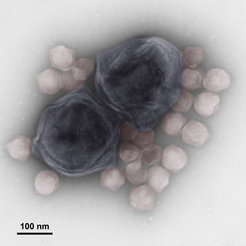Viruses protect their hosts from other viruses
When both sides profit - within this mutually beneficial symbiosis, virophages act as a defense system against giant viruses for their marine protist hosts
Scientists at the Max Planck Institute for Medical Research in Heidelberg show that a group of viruses termed ‘virophages’ are often found within the genomes of their planktonic host. Expanding on their previous findings that virophages protect the plankton from being infected by so-called giant viruses, they now show that these beneficial virophages are present in four wild populations of the marine protist Cafeteria. The results, which were recently published in eLife, suggest that this mutually beneficial defense system is widespread in nature and relevant for plankton ecology and evolution.
Viruses are found in all ecosystems, where they exist in vast numbers and infect various cellular organisms. Not all viruses are bad for their hosts though, and a group of viruses termed ‘virophages’ can even protect their planktonic hosts from being infected by so-called giant viruses, which would otherwise kill the host. In order to replicate, virophages need to find a host cell that is infected with a giant virus, because virophages need certain enzymes from the giant virus to express their own genes. Since virophages need two biological entities (host cell and giant virus), they can increase their chances for replication by attaching to one of the two.

Researchers from the Protist Viruses Research Group at the MPI for Medical Research in Heidelberg are studying the virophage mavirus, which integrates its genome into the DNA of the marine protist Cafeteria sp. Apart from this bacteria-eating single-celled organism, other examples of protists include amoebae, microscopic algae, the ciliate Paramecium and human parasites such as Plasmodium or Toxoplasma. Once the virophage is part of the Cafeteria genome, it becomes active only when the giant virus CroV infects the host cell. The newly released mavirus particles will then inhibit the replication of CroV during subsequent co-infections. Following the old proverb "the enemy of my enemy is my friend", a population of Cafeteria sp. cells may thus survive an infection with CroV in the presence of mavirus. Therefore, the virophage likely acts as a defense system for the host.
So far, the scientists, led by research group leader Matthias Fischer, examined this system under controlled laboratory conditions, using a single host strain, a single giant virus strain, and a single virophage strain. To test whether virophages really work as a defense system against giant viruses in wild Cafeteria populations and determine the relevance of such a system in nature, the researchers now analyzed four populations of Cafeteria, isolated from Atlantic and Pacific waters, for integrated virophages.
“Our experiments with laboratory-grown cultures and viruses put us on the track of this fascinating defense system,” explains Fischer. “Then, it was time to look beyond the test tube and search for evidence of the Cafeteria-virophage symbiosis in the environment. We used the latest DNA sequencing technology and pieced together the genomes of Cafeteria populations from four different oceanic regions to look for integrated virophages.”
The group not only found close relatives of the cultured mavirus strain, but seven new virophage types that were only distant relatives of mavirus and which might protect the host from other types of giant viruses. Each of the four Cafeteria genomes contained dozens of virophage genomes, which strongly suggests that virophages are indeed important for the ecology and evolution of this group of marine protists.
However, when the researchers compared the virophage locations in the four host genomes, only a small number of them were shared by all Cafeteria populations. This indicates that virophage integration is a dynamic and ongoing process in nature and shows that virophages are highly active and abundant in marine ecosystems.
“The fact that we found so many virophages in these protists is an important step towards unravelling their role in the environment,” Fischer says. “We can now combine the new findings with lab experiments to test the activity and function of all these virophages.”
Unexpectedly, the team also discovered another type of mobile DNA element, called retrotransposon, hidden in the host genome. The retrotransposons often interrupted the integrated virophage sequences, thus revealing a new player in this already crowded microbial system.
“It’s fascinating that even viruses of other viruses appear to have their own little parasites. The continuous competition between cells, viruses, and mobile genetic elements is an important source of innovation and teaches us a lot about how evolution works.”
